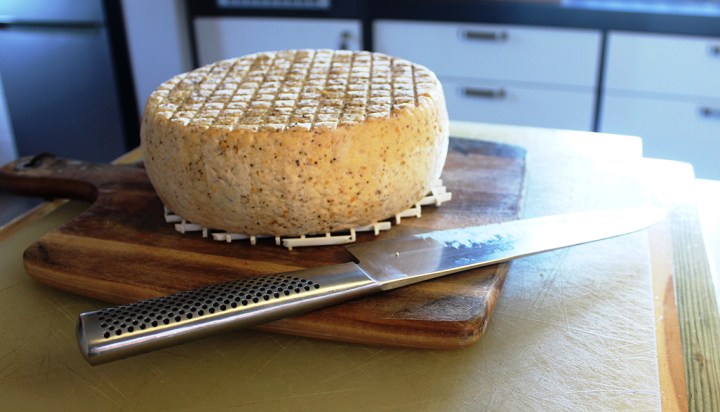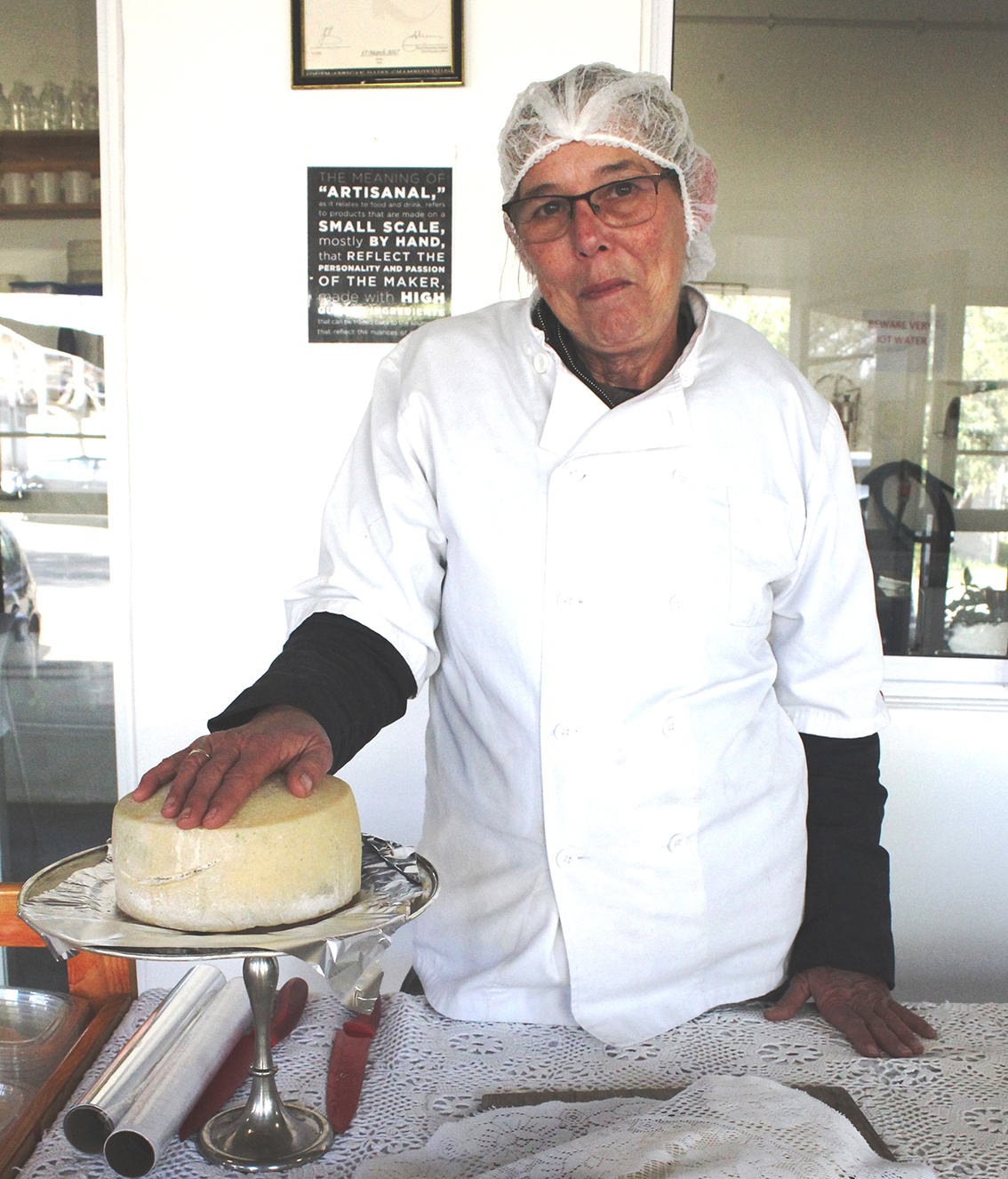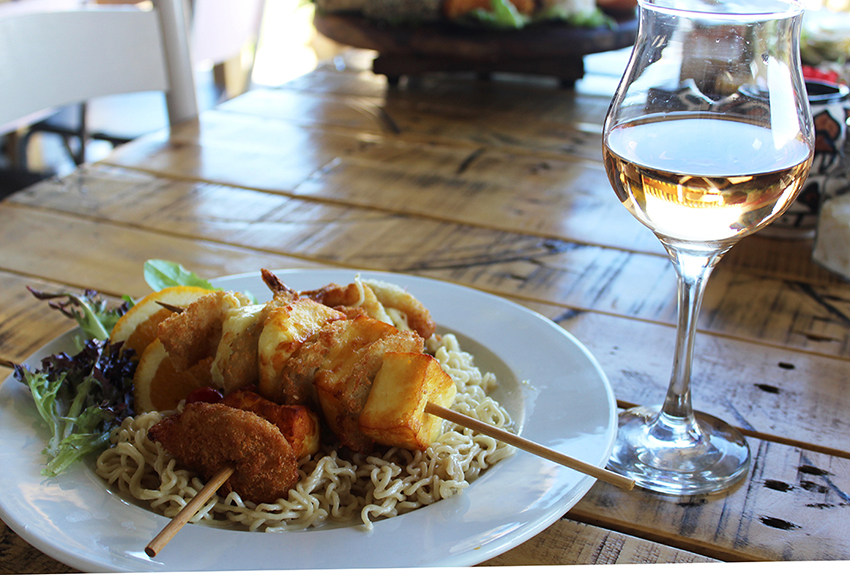CULTURE CLUB
The West Coast Cheese Renaissance

The West Coast is a territory of contrasts, from the bleak to the sublime. And every so often, it tosses up a surprise. Meet the cheeseries, cheeses and cheesemakers of the Weskus.
Legend has it that making cheese first occurred around 8,000 BC when fresh milk was being transported in the repurposed stomachs of recently domesticated sheep. Not only were the stomachs leak-proof, but they also contained residues of rennin, the enzyme naturally present in the intestinal tracts of all ruminants. The rennin curdled the milk, separating it into curds and whey. If our Neolithic pastoralists drained off the whey then added a little salt to the remaining curds, the result was… cheese.
Even if the story isn’t true, and that we’ll never know, what is certain is that cheese has been part of Homo sapiens’ diet for a very long time. The first milk used for cheese was from goats or sheep as these were the most prevalent livestock in the vicinity of the Fertile Crescent. Ancient Sumerian records going back as far as 4,000 BC reflect evidence of cheese consumption in those times and cheesy remains found in clay pots dating back to 2,300 BC showed that the Egyptians were also fond of the stuff.
For the cheese eaters who make up the mass consumer markets prevalent in places like the US and certainly South Africa, moo cow milk and cheese resonate with the same veracity as fish and chips… and factory Cheddar rules. But if truth be told, in many more of the world’s more traditional societies, milk from goats, sheep, yaks, horses, buffalo or even camels is what finds its way into whatever cheese vat is being used to concoct the local favourite fromage.
So wherever you are in the world and if you like cheese, chances are that a taste of what the ordinary folk regard as good cheese will clear a portal into that region’s culture and ethnicities. The cheeses of the world have been shaped by its history and traditions. Just like every wine of origin has its terroir, so does a cheese hand-crafted in Tuscany, the Canary Islands or Velddrif.
Velddrif? But that’s on the South African West Coast, an austere and somewhat arid coastline, better known for bokkoms, gevlekte snoek braais and the rough-shod hospitality of its salty fisherfolk and tough-as-teak farmers. The West Coast, or Weskus as most of its inhabitants refer to it, is not a place where discerning travellers might expect to discover culinary innovations or sophisticated palates being teased with extraordinary tastes. But hang on – isn’t Darling on the West Coast and at one time home of Hildagonda Duckitt? The grande dame of Cape cuisine who immortalised herself as South Africa’s Mrs Beeton with the Victorian publication of her seminal Hilda’s “Where Is It?” of Recipes.
Or Wolfgat, the minuscule seaside restaurant that is tiny Paternoster’s contribution to international cuisine. A local chef with the most unlikely name of Van der Merwe has suddenly become responsible for placing the village on the world foodie map. Amazing.
And further up the coast, a sip of Lutzville Vineyard’s award-winning Shiraz Rosé will confirm that the wine can hold its own in any company, anywhere in the world.
Yep, the West Coast is certainly a territory of contrasts with offerings that range from the bleak to the sublime and every so often, it tosses up a surprise. But we were talking about terroirs and that apparently most pedestrian of places, Velddrif, where the Berg River drains into the Atlantic.
There we find artisan cheesemaker David Malan of Kokerboom Kaas turning out a saline rind-washed cheese that turns naturally and without any aid to a yellow, almost golden colour. The extraordinary aspect of this process is that under normal circumstances the cheese maker would have introduced the culture Brevibacterium linens into the cheese and also the wash to arrive at an end result that would be similar to a surface-ripened Limburger, Munster or Gruyère. Note that some of the most notorious stinkers of the cheese world including the shocking Epoisses de Bourgogne are made this way.

David Malan and his Baby Blues. Photo: Andrew Newby
“It’s important to understand that Brevibacterium linens simply loves a salty environment. That’s why we use a saline solution for our rind-washed cheeses, to create a home for it. But look out the window…,” said David.
The view out of his cheesery window featured Velddrif’s familiar salt marshes all the way across to the Berg River. Most of the country’s salt producers, including Cerebos and Khoisan Sea Salt, are there. And so is Brevibacterium linens, already lurking in the pans, just waiting to drift in on a light breeze through the window to find a home in the beckoning rinds of his salt-washed cheeses.
But Velddrif’s naturally occurring saline environment is not the only factor that contributes to the unique terroir of David Malan’s Kokerboom Kaas range. The rich Golden Guernsey A22-rated milk from Ruben Kotze’s Helderwater Farm just up the road to Hopefield play a significant role in what form the cheeses eventually take.
“The Guernsey milk is creamier than most other milk,” David explained, “and milk from this particular herd is reputed to be kinder to lactose-intolerant people.”
As is the case of wine, climate plays a big role and every cheesemaker who is not operating in a climate-controlled factory environment knows that summer and winter have to be taken into account.
Kokerboom Kaas is finding increasing acceptance at local markets. Every Saturday morning David schleps his wares across to Hopefield’s fabulously-stocked Mill Market and is sold out within two hours. He’s particularly proud of an item on British restaurateur Russell Foster’s classy new restaurant, Russell on Port, in Port Owen where the menu features “Dave Malan’s Stilton-style Blue with Glazed Figs”.
“I was in the restaurant when a diner commended Russell on the blue cheese,” said David. “Russell replied ‘don’t praise me – talk to that guy sitting behind you – he’s the cheesemaker’. At that moment I felt so good because a complete stranger had affirmed my craft.”
He’s also busy working with Charlie’s Brew House, another Russell Foster initiative, to produce a cheese that will pair with some of the microbrewery’s speciality beers. It goes under the name of ‘Charlie’s Gold Rush’ and features desiccated orange zest and roast coriander, being cured in American pale ale.
“Our cheeses are unique to us. While we make cheeses in the style of many famous varieties, we rename them to create a local heritage. So a Stilton-style cheese becomes a ‘Black Wing Stilt’, a Manchego-style we call a ‘Flamingo’ and a Fontina-style cheese is a ‘Francolin’.”
Okay, so that’s Velddrif, but where else is there evidence of a West Coast cheese renaissance? Let’s zip south to Darling, a little town that’s increasingly becoming the crucible of many things good and tasty. Apart from the well-known Darling Brew’s offerings in the craft beer department, there’s a clutch of other gems nestling in Hildagonda’s old stamping ground, among them The Flying Pig charcuterie and Carla Bryan’s Udderly Delicious cheesery which is an inspiration to any aspiring artisan cheese maker.

Carla Bryan with her Skattie. Photo: Andrew Newby
Carla attended a cheesemaking course in Durbanville about 10 years ago and has been at it ever since. This is a woman who takes her cheese activities so seriously that they could be the main mission in her life: to spread the good word and merits of artisanal cheesemaking far and wide. Her little shop sometimes doubles as a restaurant and her cheesery is part of the small complex, in full view of anyone who might want to watch her at work. A permanent cheese-tasting setup is laid out in the front, and if Carla is too busy to conduct a quick tasting and explain some of the finer aspects of the craft, one of her staff will step in.
First order of her day is to fetch her milk, which she does herself from the dairy of a Darling farmer with whom she has an ongoing arrangement. She hefts 120 litres of “morning milk”only recently coaxed from the udders of contented Friesland cows, in 25-litre plastic buckets on to the back of her ancient Toyota bakkie. Back at Udderly Delicious she transfers the milk into her pasteuriser/cheese vat for pasteurisation before commencing with any further cheesemaking activities.
“I make a lot of soft fresh cheese, so I don’t want any problems down the line. That’s why I pasteurise,” she explained, adding that she has been influenced profoundly over the years by the Italian cheesemaking tradition.
Carla has narrowed her product range down to only four types: a Caciotta as well as a black pepper version of it, a creation called a Skattie which she developed herself and a Mascarpone fresh cheese.
“I concentrate on what people want and what I can make consistently well,” she said firmly.
The Caciotta, which has won awards, is definitely the dreamy creation of Carla Bryan. Yes, if you have a squiz in cheese reference books or Google it, you will find confirmation that there is indeed an Italian soft cheese called a Caciotta. In fact, there are numerous recipes for it and apparently, it can be made from a variety of milk. But the Udderly Delicious version is truly unique; something like a combination of feta and brie. But not briny and certainly with no traces of ammonia. It’s a gentle everyday eating cheese with a pièce de résistance – on cutting, its interior spills out softly to offer a sweetish creamy contrast to the mushroom-like tones of an eminently edible rind. “We sell a lot of it,” said Carla.
The unpretentiously named “Skattie” belies the thought and skill that has gone into the design and making of this homely-looking little cheese. Carla describes it somewhat vaguely as something “between a Cheddar and Gouda”. So one might be forgiven for thinking of a R69.95/kg hybrid that could be found in a Pick n Pay dairy department bin between chunks of cling-wrapped Gouda and Cheddar. No, this Skattie (so-named because apparently it’s everyone’s favourite) speaks to the palate of nuanced combinations and complex flavours.
This is because Carla has extended her artisan innovation to combine the manufacturing techniques of both cheese varieties in a single process. When inoculating her milk she includes a mesophilic culture (that becomes excited at lower temperatures) as well as a thermophilic culture (that enjoys higher temperatures). Then after the curd-cutting stage she removes some of the whey and replaces it with warm water – this is known as curd-washing and is part of the Gouda process. The vat temperature is subsequently increased slowly so that the thermophilic culture can kick in at around 36°C. At a suitably high temperature she employs the stirred-curd method which is one of the techniques used in the making of cheddar types. The result is then drained, salted, moulded and pressed to become a Skattie after two month’s ripening in Udderly Delicious’ walk-in cheese cave.
Some of Carla Bryan’s cheese goes to Darling Brew’s tasting room and eatery where it features on the establishment’s popular cheese platter. A lot more finds its way to the Wild Peacock Food Emporium, a wholesale specialty food distributor in Stellenbosch. From there it moves on to restaurants and delis in foodie centres such as Franschhoek. Apart from her own cheeses that she moves through her shop, she offers a selection of some of South Africa’s finest cheeses. A case in point is a creation that goes by the name of Karoo Crumble which arrives in large wheels from Francy Schoeman’s cheesery at Langbaken, just outside Williston. The sample I tasted yielded a slight “crunch” pointing to its creator’s achievement in securing the Holy Grail in mature Cheddar cheese making – the minutely granular “crunch” that signifies the presence of the formation of tyrosine and possibly calcium lactate crystals. I have no words to describe its excellence.
Are there any other trailblazers on the West Coast? Yes, of course there are, but there’s only sufficient space to talk about one more. We could, of course, visit Camphill Village, only 40km north of Cape Town, which provides a safe environment for between 80 and 90 intellectually challenged adults in which to live and work, so that they can experience a meaningful and fulfilling life. The residents of this remarkable organisation turn out an outstanding assortment of organic yoghurt, sweet milk cumin cheese, Quark, Feta and crème fraiche. Or we could move back to Helderwater between Hopefield and Velddrif to find out a bit more about the Feta, Cheddar and cream cheese that originates from the milk of that farm’s fabled Golden Guernsey herd and sold under the name Helderwater. And further north up at Lambert’s Bay on a farm called Bettiesville, WA Hugo and his wife Lillibet’s herd of Saanens is the source of some of the finest goat cheese in the land – an assortment of Chevré, Haloumi and Feta – sold in health shops under the Bettie Bok brand.
But let’s finish off at an idyllic spot that hardly anyone’s ever heard of. It’s called Trekoskraal and it’s just off the road between Vredenburg and Paternoster. At the Afsaal Padstal we find Alta Nel, who’s been at it longer than anyone else. Twenty-five years in fact.

Alta Nel of Trekoskraal with her cheesecake and cheese board. Photo: Andrew Newby
Trained as a physiotherapist and married to Wilhelm, a doctor who practises in Vredenburg, Alta decided a long time ago that the slow life was for her. “We bought a basic cheesemaking kit from Finest Kind (the pioneering cheese equipment supplier on the Garden Route) and began with the easy cheeses,” she said. That was the beginning of an intimate and ongoing relationship with the curd.
“I discovered that there was something extremely satisfying working with a natural raw material such as milk. The fact that I was working with my hands, making something that was useful and that was enjoyed by people appealed to me. Making cheese is a slow satisfying process.”
The Nels lead a simple, almost self-sufficient life at Trekoskraal. For those in the know, the Afsaal Padstal is a farmstall that epitomises the notion of what a country farmstall should be. Its fridges are packed with local produce and freshly-baked cakes are on display on rustic tables. Visitors can peruse Alta’s extraordinary array of cheeses, ranging from unusual little Camembert-type cylinders to herb-infused Goudas, Fromage Blancs, blue cheeses and a creation that looks similar to a Manchego – except that it’s made from milk that comes from a cow instead of a Spanish sheep. Packed into small square bottles with garlic-infused oil, deceptively resembling quails’ eggs, are speckled balls of herb-rolled Labna. The cheeses are sold under the label “Altwic Cottage”.
“Sometimes I put together a cheesecake. It’s always popular,” she told me.
Wilhelm takes time off from his medical responsibilities to milk their Jersey cows and on Sundays puts his hand to a spell of cheesemaking as well. “This one is one of his,” remarked Alta, lifting a wheel of what looked like komijnekaas. “It turned out quite well.”

An Afsaal Padstal cheese lunch of deep-fried haloumi and prawn kebabs with a light anchovy cream sauce. Photo: Andrew Newby
We were sitting on the Afsaal’s stone-built veranda. From our elevation with the coastal fynbos directly in front and a glittering blue Atlantic several kilometres away, we had an idyllic view. It was a perfect day and Alta had insisted on serving a “cheese” lunch – deep-fried haloumi and prawn kebabs on a bed of noodles dressed with a light cream and anchovy sauce. Clearly, the Nel’s Jersey cow had made a significant contribution to our meal.
“You know, I make cheese to make not only myself happy, but to make others happy too. I love this slow life and being close to nature. I also love to talk to the people who visit and explain how everything is done. I don’t need lots of money – enough to pay my staff and buy a few things. Cheesemaking has brought me inner peace and great joy over the years,” she told me.
As I headed from Trekoskraal on the road to Vredenburg I reflected on these cheesemakers that I had been visiting. Each in his or her distinct way was very different from the other… different personalities reflected in the varying forms of cheeses that each one makes. But what they all had in common was this deep empathy to craft a product that is as old as a civilisation that began in Mesopotamia so many aeons ago.
After all, the act of transforming perishable milk into a protein-rich, relatively durable, life-sustaining substance was one of the big events in our culinary history. And the West Coast artisanal cheese makers uphold this tradition with pride and panache. DM





 Become an Insider
Become an Insider